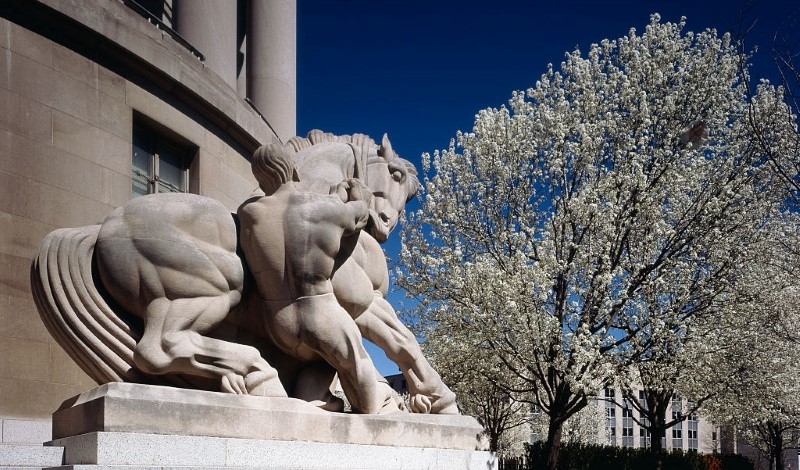
Scholar highlights the dissonance between law enforcement authorities and proposes coordination solutions.
From Aesop’s Fables comes this timeless warning: “United we stand, divided we fall.”
According to one scholar, antitrust law is not immune from this cautionary message.
In a recent article, Christine P. Bartholomew, a professor at the University at Buffalo School of Law, argues that antitrust enforcers are mired in an ecosystem of hostility and infighting. Without increased collaboration and unity among antitrust enforcers, antitrust will continue to suffer, leaving the American public exposed to harms that stifle competition in markets, Bartholomew claims.
Bartholomew identifies two concrete steps within the antitrust ecosystem that enforcers can take to achieve harmony: adopt guiding principles and create an all-enforcer working group.
Bartholomew observes two camps of enforcement: public and private. Enforcement authority on the public side rests in both federal and state government structures.
Two agencies—the Federal Trade Commission (FTC) and the U.S. Department of Justice—bear the enforcement burden for the federal government. For states, attorney generals and state antitrust agencies enforce both state and federal antitrust laws.
Consumers, who often band together to form class actions, dominate the private enforcement landscape, notes Bartholomew. Because of litigation costs and limited recovery, Congress granted substantial monetary incentives to successful private enforcers to encourage aggregate litigation, Bartholomew argues.
Federal antitrust law enables multiple enforcers—public and private, state and federal—to pursue and deter violators concurrently. Bartholomew states that Congress designed overlapping private and public enforcement authority to maximize oversight.
This “belt and suspenders approach” is an intentional and beneficial power dispersion, Bartholomew explains. Placing public and private enforcement on equal and overlapping footing fuels the agility of antitrust laws, she argues.
Bartholomew suggests that this enforcement overlap compensates for resource constraints, remedies errors and information problems, and drives healthy competition among enforcers. At a base level, this overlap protects healthy markets from becoming sick because redundancy increases overall reliability, Bartholomew argues.
Bartholomew warns that without reliable antitrust enforcement, the benefits of the law—from competitive prices to innovation—may vanish. She contends that the prospect of overenforcement or duplicative recovery is false because each enforcer cannot duplicate relief.
Bartholomew states that “no single enforcer can, or does, shoulder the country’s full antitrust enforcement responsibility.” Each enforcer embodies inherent limitations, such as the risk of regulatory capturet the Justice Department and the inability of collecting monetary damages at the FTC.
All public enforcers face budget constraints as funding fluctuates with administration changes. Even private enforcers faces mounting procedural barriers in litigation, which have led to an overall decrease in lawsuits, notes Bartholomew.
Bartholomew concludes that these structural and environmental conditions have ensured that no single enforcer could have the time, ability, or resources to oversee the entire economy. Instead of tackling collective problems as designed, however, enforcers have turned on one another, Bartholomew observes.
Bartholomew explores enforcer infighting with a focus on the Justice Department to identify common actions that cut against the benefits of concurrent enforcement.
First, she highlights the Justice Department’s public advocacy in other enforcer’s cases—whether or not it supports the fellow enforcer or the defendant—as demonstrating the agency’s belief that it is the authoritative interpreter of antitrust law. By exceeding the bounds of its proscribed authority, these interventions reveal “a presumption of primacy,” Bartholomew argues. She concludes that these repeated challenges to co-enforcers provide arm anti-regulatory aims to restrict competition oversight overall.
Second, Bartholomew contends that the Justice Department has transformed “from champion to challenger” for private enforcers, and has attacked class-actions in general. With weakened private enforcement, a vacuum in the antitrust ecosystem would open in perpetuity, Bartholomew observes.
Finally, the Justice Department has shifted to pursuing lengthy stays, which press pause on private enforcers, in parallel civil cases. These stays threaten the prospect of victim compensation and weaken the integrity of evidence, Bartholomew notes. She argues that the Justice Department has other, less intrusive procedural tools than a stay but remains opposed to using them.
Bartholomew urges regulators to minimize conflict and proposes a set of agile guiding principles to facilitate harmony among enforcers: harnessing the benefits of multiple enforcers, avoiding mission drift, and sharing enforcement power.
Some level of disagreement between co-enforcers is inevitable—and even productive—because it disables groupthink and encourages healthy competition, Bartholomew concedes. She warns that the current levels of disagreement, however, pose “an existential hazard” to the enforcement ecosystem.
By interfering with one another’s work, each enforcer forfeits the benefits of coordination—such as information sharing and expertise—and instead exhausts one another’s limited resources. Instead of non-interference, Bartholomew proposes an expectation that enforcers work together on litigation strategies when possible to minimize costs and use each enforcer’s inherent strengths.
In addition, Bartholomew urges all enforcers to return to the beating heart of antitrust law—maximizing deterrence and victim compensation—to avoid straying from their missions. If enforcers lose sight of these goals, they can waste resources and even enable regulatory capture, she argues. Reorienting enforcers toward enforcement lies at the core of avoiding mission drift, Bartholomew stresses.
She also suggests that enforcers “share the enforcement lane” and avoid litigation procedures that would halt or hinder co-enforcement. By refraining from unnecessary stays and opposing briefs, enforcers can avoid blocking one another’s actions, Bartholomew reasons.
To facilitate and amplify these principles, Bartholomew advocates the creation of a “U.S. Antitrust Enforcement Working Group,” with equal representatives for the FTC, Justice Department, state attorneys general, and private enforcers’ bar.
Bartholomew contends that creating this group would provide a marketplace for antitrust ideas to flow and respect and trust to flourish. Furthermore, this institution would advance interdependence and communication, while avoiding damaging public disputes that undermine co-enforcers, she notes.
Bartholomew underscores that guiding principles paired with a working group could calm enforcer dissonance and ensure that law enforcement is “greater than the sum of its parts.” Without collaboration and unity, division will continue to weaken competition oversight and leave the American public more vulnerable than ever to harm, Bartholomew concludes.



